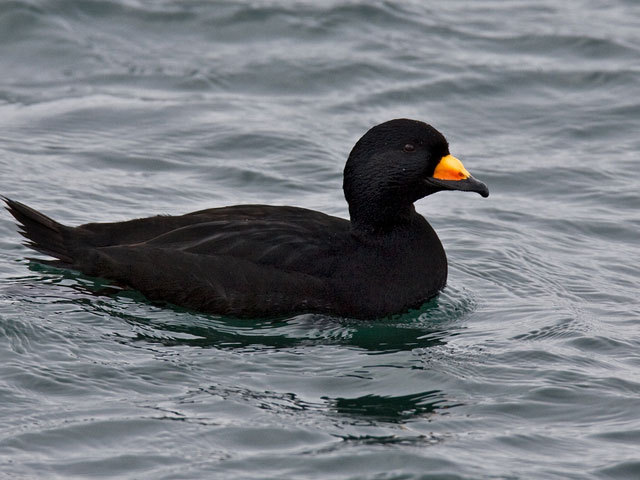I got fooled again. My wife and I were recently looking out over Johnson Bay, a small embayment in Lubec that is a part of Cobscook Bay. Over the water I saw a long string of dark material. I thought it was a line of algal wrack, carried offshore by the powerful tides in Cobscook Bay and caught at the interface between two currents.
But no, the wrack started to disappear. I was looking at a flock of about 150 Black Scoters.
Black Scoters outside of the breeding season are often gregarious, sticking close together on the water either in a snake-like conga line or in a tight circle. I don’t know of any other ducks that engage in this behavior. Perhaps you have seen Black Scoters in tight formations. This linear arrangement is seen in flight as well. A line of scoters will fly just above the sea, rising and falling as they pass over waves.
Black Scoters are one of three scoters that are seen regularly in Maine from the fall until the late spring. Surf Scoters and White-winged Scoters are the other two species.
Black Scoters were once called Common Scoters in North American field guides. As a budding birder in North Carolina, I was perplexed by the name because Surf Scoters and White-winged Scoters were far more “common” than the Common Scoter. I like Black Scoter better.
By the way, if you are wondering about the derivation of the name “scoter,” its origin is unknown.
Black Scoters are pretty easy to identify. Adults males are entirely black except for a yellow-orange protuberance on top of the bill. That protuberance can be seen from great distances through binoculars. Females are dark brown except for a distinctive two-toned head (dark cap and whitish cheeks). Both sexes are fairly easy to distinguish from the other two scoters.
Some controversy exists over whether the Black Scoters we have in North America are the same species as the ones occurring in Europe and Asia. The Old World form (subspecies or species) is called the Common Scoter.
Black Scoters winter along both coasts of North America, from the Aleutians to the Baja Peninsula on the West Coast and Newfoundland to the central Texas coast in the East. Despite the broad distribution, Black Scoters are one of our least-known ducks. The main reason for this lack of information stems from the highly disjunct and limited breeding range. These scoters nest on lakes in northwestern Alaska and northern Quebec. Much remains to be learned about their breeding behavior and ecology.
Black Scoters dive for their food but are not chasing fish as many birders assume. Rather, they are bottom feeders.
In freshwater, Black Scoters feed mainly on aquatic insects, with a particular fondness for caddisfly larvae. In marine waters, the diet is mostly bivalves (clams and mussels) and snails. Scoters usually feed in waters less than 30 feet deep. Once at the bottom, they may take mussels or snails on the surface or excavate the sediment to extract buried clams. It’s no surprise they need to be in fairly shallow water.
Black Scoters are powerful divers. On the surface of the water with their wings closed, they seem to leap above the water and neatly slice into it, disappearing in the blink of an eye. Sometimes they propel themselves with their feet and, in some populations, they will use half-extended wings to help propel them to the bottom.
Which brings us back to the beginning. Why arrange themselves in tight lines or circles? If scoters were fish eaters, perhaps they could herd fish into a tight ball. But no one needs to herd sessile mussels or slow-moving snails. We have to simply accept the fact that Black Scoters are sociable creatures.
Herb Wilson teaches ornithology and other biology courses at Colby College. He welcomes reader comments and questions at:
whwilson@colby.edu
Copy the Story Link
Send questions/comments to the editors.



Success. Please wait for the page to reload. If the page does not reload within 5 seconds, please refresh the page.
Enter your email and password to access comments.
Hi, to comment on stories you must . This profile is in addition to your subscription and website login.
Already have a commenting profile? .
Invalid username/password.
Please check your email to confirm and complete your registration.
Only subscribers are eligible to post comments. Please subscribe or login first for digital access. Here’s why.
Use the form below to reset your password. When you've submitted your account email, we will send an email with a reset code.